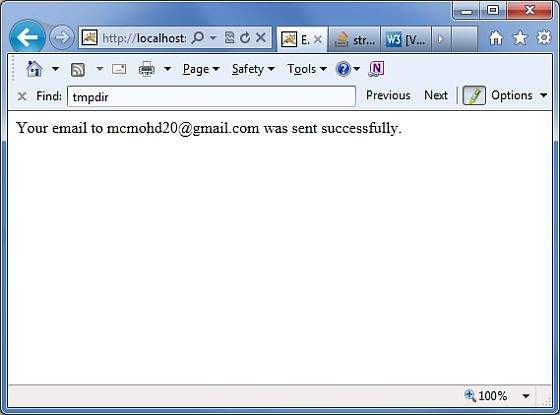Struts2 sends an email
May 15, 2021 Struts2
Table of contents
This chapter will teach you how to send e-mail using the Struts2 application. B efore you can learn, you need to download and install the mail .jar from JavaMail API 1.4.4, put the mail.jar file in the WEB-INF-lib folder, and then continue to follow the standard steps below to create actions, views, and profiles.
Create Action
The first is to create an Action method to handle e-mail sending. L et's create a new class called Emailer .java the following:
package cn.w3cschool.struts2;
import java.util.Properties;
import javax.mail.Message;
import javax.mail.PasswordAuthentication;
import javax.mail.Session;
import javax.mail.Transport;
import javax.mail.internet.InternetAddress;
import javax.mail.internet.MimeMessage;
import com.opensymphony.xwork2.ActionSupport;
public class Emailer extends ActionSupport {
private String from;
private String password;
private String to;
private String subject;
private String body;
static Properties properties = new Properties();
static
{
properties.put("mail.smtp.host", "smtp.gmail.com");
properties.put("mail.smtp.socketFactory.port", "465");
properties.put("mail.smtp.socketFactory.class",
"javax.net.ssl.SSLSocketFactory");
properties.put("mail.smtp.auth", "true");
properties.put("mail.smtp.port", "465");
}
public String execute()
{
String ret = SUCCESS;
try
{
Session session = Session.getDefaultInstance(properties,
new javax.mail.Authenticator() {
protected PasswordAuthentication
getPasswordAuthentication() {
return new
PasswordAuthentication(from, password);
}});
Message message = new MimeMessage(session);
message.setFrom(new InternetAddress(from));
message.setRecipients(Message.RecipientType.TO,
InternetAddress.parse(to));
message.setSubject(subject);
message.setText(body);
Transport.send(message);
}
catch(Exception e)
{
ret = ERROR;
e.printStackTrace();
}
return ret;
}
public String getFrom() {
return from;
}
public void setFrom(String from) {
this.from = from;
}
public String getPassword() {
return password;
}
public void setPassword(String password) {
this.password = password;
}
public String getTo() {
return to;
}
public void setTo(String to) {
this.to = to;
}
public String getSubject() {
return subject;
}
public void setSubject(String subject) {
this.subject = subject;
}
public String getBody() {
return body;
}
public void setBody(String body) {
this.body = body;
}
public static Properties getProperties() {
return properties;
}
public static void setProperties(Properties properties) {
Emailer.properties = properties;
}
}
As shown in the source code above, emailer.java has a genus corresponding to the form properties .jsp the email page given below, which are:
-
From - The sender's email address. Since we use Google's SMTP, we need a valid gtalk ID.
-
password - the password for the above account
-
To - Who do you send e-mail to?
-
Subject - The subject of the e-mail message
-
body - the actual e-mail content
We have not considered any validation of the above fields, which will be added in the next chapter. L et's look at the execute() method, the execute() method that sends e-mail using the parameters provided by the javax Mail library. I f the message is successfully sent, action returns to SUCCESS, otherwise returns ERROR.
Create a home page
The current JSP file index for the home page .jsp, which will be used to collect information about the email mentioned above:
<%@ page language="java" contentType="text/html; charset=ISO-8859-1" pageEncoding="ISO-8859-1"%> <%@ taglib prefix="s" uri="/struts-tags"%> <!DOCTYPE html PUBLIC "-//W3C//DTD HTML 4.01 Transitional//EN" "http://www.w3.org/TR/html4/loose.dtd"> <html> <head> <title>Email Form</title> </head> <body> <em>The form below uses Google's SMTP server. So you need to enter a gmail username and password </em> <form action="emailer" method="post"> <label for="from">From</label><br/> <input type="text" name="from"/><br/> <label for="password">Password</label><br/> <input type="password" name="password"/><br/> <label for="to">To</label><br/> <input type="text" name="to"/><br/> <label for="subject">Subject</label><br/> <input type="text" name="subject"/><br/> <label for="body">Body</label><br/> <input type="text" name="body"/><br/> <input type="submit" value="Send Email"/> </form> </body> </html>
Create a view
Now create
a .jsp file,
which will be called if action
returns SUCCESS results, but if we return ERROR results from action, we will use another view file.
<%@ page language="java" contentType="text/html; charset=ISO-8859-1" pageEncoding="ISO-8859-1"%> <%@ taglib prefix="s" uri="/struts-tags"%> <!DOCTYPE html PUBLIC "-//W3C//DTD HTML 4.01 Transitional//EN" "http://www.w3.org/TR/html4/loose.dtd"> <html> <head> <title>Email Success</title> </head> <body> Your email to <s:property value="to"/> was sent successfully. </body> </html>
The following will be the view file error
that is called when action returns ERROR.jsp.
<%@ page language="java" contentType="text/html; charset=ISO-8859-1" pageEncoding="ISO-8859-1"%> <%@ taglib prefix="s" uri="/struts-tags"%> <!DOCTYPE html PUBLIC "-//W3C//DTD HTML 4.01 Transitional//EN" "http://www.w3.org/TR/html4/loose.dtd"> <html> <head> <title>Email Error</title> </head> <body> There is a problem sending your email to <s:property value="to"/>. </body> </html>
Profile
Finally, let's use .xml to put everything together using the struts configuration file, as follows:
<?xml version="1.0" encoding="UTF-8"?>
<!DOCTYPE struts PUBLIC
"-//Apache Software Foundation//DTD Struts Configuration 2.0//EN"
"http://struts.apache.org/dtds/struts-2.0.dtd">
<struts>
<constant name="struts.devMode" value="true" />
<package name="helloworld" extends="struts-default">
<action name="emailer"
class="cn.w3cschool.struts2.Emailer"
method="execute">
<result name="success">/success.jsp</result>
<result name="error">/error.jsp</result>
</action>
</package>
</struts>
Here's .xml the web file:
<?xml version="1.0" encoding="UTF-8"?>
<web-app xmlns:xsi="http://www.w3.org/2001/XMLSchema-instance"
xmlns="http://java.sun.com/xml/ns/javaee"
xmlns:web="http://java.sun.com/xml/ns/javaee/web-app_2_5.xsd"
xsi:schemaLocation="http://java.sun.com/xml/ns/javaee
http://java.sun.com/xml/ns/javaee/web-app_3_0.xsd"
id="WebApp_ID" version="3.0">
<display-name>Struts 2</display-name>
<welcome-file-list>
<welcome-file>index.jsp</welcome-file>
</welcome-file-list>
<filter>
<filter-name>struts2</filter-name>
<filter-class>
org.apache.struts2.dispatcher.FilterDispatcher
</filter-class>
</filter>
<filter-mapping>
<filter-name>struts2</filter-name>
<url-pattern>/*</url-pattern>
</filter-mapping>
</web-app>
Now, right-click on the project
name, and then click
"Export" and "WAR File" to
create a WAR
file. T
he WAR file is then deployed in Tomcat's webapps directory.
Finally, start the Tomcat server and try to access the URL http://localhost:8080/HelloWorldStruts2/index.jsp display the following interface:

Enter the information you want, and then click the Send Email button. If all goes well, you can see the following pages:
